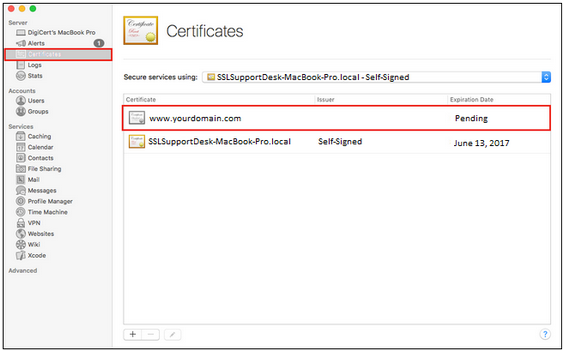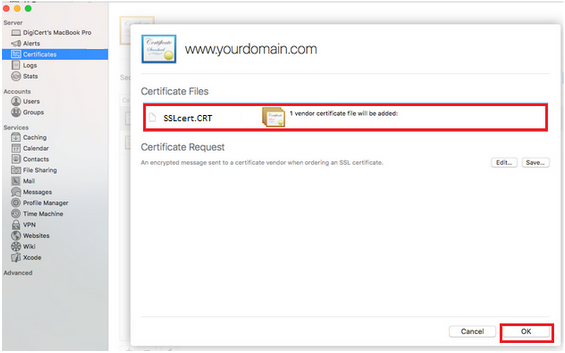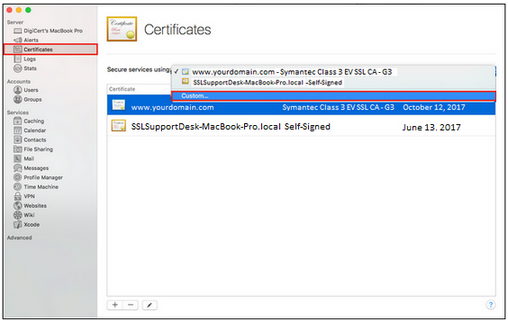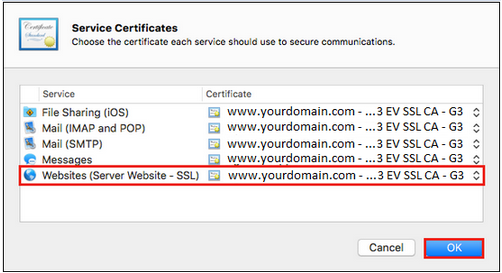Like the majority of server systems you will install your SSL certificate on the same server where your Certificate Signing Request (CSR) was created. Your private key will always be left on the server system where the CSR was originally created. Your SSL certificate will not work without this private key file. We will assume that this is the original system.
To Install your SSL certificate on a Mac OS X 10.11 system perform the following.
Step 1: Downloading your SSL Certificate & its Intermediate CA certificate:
- If you had the option of server type during enrollment and selected Other you will receive a x509/.cer/.crt/.pem version of your certificate within the email. Alternately you can access your Certificate User Portal by the supplied link in the email to pick up the x509 version of your certificate.
- Copy the SSL certificate and make sure to copy the —–BEGIN CERTIFICATE—– and —–END CERTIFICATE—– header and footer Ensure there are no white spaces, extra line breaks or additional characters.
- Use a plain text editor such as Notepad, paste the content of the certificate and save it with extension .crt
- If your intermediate CA certificate for your product is not in the body of the email you can access your Intermediate CA also in a link within that email. Copy and paste the contents of your Intermediate CA into its own Notepad file and save it with a .crt extension also.
Note: Some CAs may require two intermediates for best compatibility. These two are to be copied within their own corresponding .crt files and installed one at a time in a repeated process for intermediate installation.
Step 2: Installing your SSL Certificate:
- Open the Server App by going to the finder window > Favorites > Applications and click Server.

- In the Server App window, under Choose a Mac, do one of the following options to select the server on which you want to install your SSL Certificate.
Note: This must be the same system where the CSR was generated- To install the certificate on this server
- Select This Mac – YourServerName and then click Continue.
- Enter your Administrator Name and Administrator Password and then click Allow.
- To install the certificate on another server.
- To install the certificate on this server
- In the Server App window, under Server, click Certificates.

- On the Certificates page, double click your pending certificate request.
- Under Certificate Files, drag and drop you SSL Certificate .crt file into the window.
- Click Ok.

Your SSL Certificate should now be installed and ready for binding to its website.
Step 3: Importing your Intermediate CA:
- Open Keychain Access going to the Finder window > Favorites > Applications.
- Expand Utilities.
- Double click KeyChain Access.

- With the Keychain Access window open, go up to the Keychain Access menu at the top and select File and then click on Import Items.
Note: Alternately you can also just drag your Intermediate CA .crt file into the certificates listed in the System Keychain, Click Add then authenticate as the administrator to authorize the change.

Your Intermediate CA certificate should now be installed.
Step 4: Assigning the SSL certificate to your website:
- Back in the Certificates window, in the Secure services using drop down list Select Custom.

- In the Service Certificates pop-up window specify your new SSL Certificate for each of the services you want it assigned to.
- Click Ok.

You SSL Certificate is now installed and configured to its websites.
If you are unable to use these instructions for your server, Acmetek recommends that you contact either the vendor of your software or the hosting organization that supports it.
Apple Support:
For support refer to Mac




